An Advanced Artificial Fish School Algorithm to Update Decision Tree for NLOS Acoustic Localization Signal Identification with the Dual-Receiving Method
Abstract
:1. Introduction
1.1. Problem and Scope
- (1)
- A novel dual-receiving structure is introduced to build our acoustic signal anchors for indoor localization systems. Meanwhile, according to the requirements of the interactions between the acoustic anchor structure and the system’s main task, we also design and implement our own acoustic signal dual-receiving process based on the adaptive RSS selecting mechanism and finish the indoor localization with stronger robustness and mobility.
- (2)
- An adaptive method for NLOS indoor localization identification named CTGSA-AFSA is introduced and tested in our man-made complex and flexible NLOS situations. According to the original artificial fish school algorithm (AFSA) method, some updating strategies including adaptive chaotic transformation, adaptive GSA optimization tactics, and energy attenuation model are implemented. These methods are used to energize the performance of the decision tree (DT) model so that the system can obtain a more trustworthy and rapid NLOS identification result. In that case, a more reliable positioning result can be obtained in complex and flexible NLOS situations.
1.2. Structures
2. Related Method and Work
2.1. Dual-Receiving Acoustic Signal Processing
2.2. Decision Tree
3. Advanced AFSA Optimization Method
3.1. Adaptive Chaotic Transformation
| Algorithm 1 Adaptive initialization method based on Chaotic Transformation. |
|
3.2. Adaptive GSA
- (1)
- The acceleration of an object is proportional to the force it receives, and inversely proportional to its mass.
- (2)
- The mutual gravitation between particles is proportional to the product of their masses and inversely proportional to the square of their distances in the universe.
- (3)
- Each particle uses force to attract other particles, and there are forces and reactions continuously.
3.3. Summary
4. System Analysis and Experiment
4.1. System Setup and Dual-Receiving Method
- If both chirp signals’ RSS values exceed the retention threshold, then only the time corresponding to the first chirp acoustic signal and the received signal shall be taken as the standard.
- If only one of them has enough RSS intensity that exceeds the retention threshold, then only the time corresponding to the stronger one and the received signal shall be taken as the standard.
- If both RSS values fail to exceed the retention threshold, the “invalid reception” command is supposed to return to the main anchor, and then the system terminates this localization loop in advance.
4.2. Experiment and Analysis
- (1)
- In the complex and flexible NLOS scenarios, the dual-receiving acoustic anchors and the adaptive acoustic signal receiving and transmitting processes improved the NLOS acoustic signal classification performance in the system significantly. Among them, the dual-receiving structure in Pattern 1 and Pattern 2 yielded no significant improvement compared with the original version, while the dual-receiving structure in Pattern 3 (running state) yielded a 15% increase in NLOS acoustic signal identification accuracy compared with the original version. Pattern 4 also showed an increase of 4~13%. It truly brings some equipment complexity, but it is considered worthwhile.
- (2)
- Compared with the identification accuracy in the static scenario, the dynamic NLOS scenarios had many differences among all methods mentioned above. Among them, since the action rules of Pattern 1 and Pattern 2 may have coincided with the NLOS coping mechanism in the system for some reason, the results of Pattern 1 and Pattern 2 were similar to those in the static NLOS scenario. However, as for Pattern 3 and Pattern 4, the results were significantly different from those in the static NLOS scenarios due to factors such as the coincidence degree of random mechanisms and rules of actions. Therefore, the system needs to select an appropriate way to produce its training data set according to the situations in the NLOS scenario during deployment, which will enable the system to play a better role. Indoor sensor networks or cognitive IoT networks are ready to obtain the users’ locations, and then they will provide the users with better locations. Finally, the networks will benefit if the users are willing to obey the notifications from this system.
5. Conclusions
Author Contributions
Funding
Institutional Review Board Statement
Informed Consent Statement
Data Availability Statement
Acknowledgments
Conflicts of Interest
References
- Chen, B.; Lan, S. Research on Museum Educational Display Based on Image Recognition Tracking. Wirel. Commun. Mob. Comput. 2022, 2022, 7314887. [Google Scholar] [CrossRef]
- Wang, H.; Shi, J.; Luo, X. Swimmer’s Posture Recognition and Correction Method Based on Embedded Depth Image Skeleton Tracking. Wirel. Commun. Mob. Comput. 2022, 2022, 8775352. [Google Scholar] [CrossRef]
- Gao, F.; Fang, W.; Sun, X.; Wu, Z.; Zhao, G.; Li, G.; Li, R.; Fu, L.; Zhang, Q. A novel apple fruit detection and counting methodology based on deep learning and trunk tracking in modern orchard. Comput. Electron. Agric. 2022, 197, 107000. [Google Scholar] [CrossRef]
- Mansoor, M.; Amin, R.; Mustafa, Z.; Sengan, S.; Aldabbas, H.; Alharbi, M.T. A machine learning approach for non-invasive fall detection using Kinect. Multimed. Tools Appl. 2022, 81, 15491–15519. [Google Scholar] [CrossRef]
- Liu, M.; Cheng, L.; Qian, K.; Wang, J.; Wang, J.; Liu, Y. Indoor acoustic localization: A survey. Hum. Cent. Comput. Inf. Sci. 2020, 10, 2. [Google Scholar] [CrossRef]
- Guzsvinecz, T.; Szucs, V.; Sik-Lanyi, C. Suitability of the Kinect Sensor and Leap Motion Controller—A Literature Review. Sensors 2019, 19, 1072. [Google Scholar] [CrossRef] [Green Version]
- Cai, C.; Zheng, R.; Luo, J. Ubiquitous Acoustic Sensing on Commodity IoT Devices: A Survey. IEEE Commun. Surv. Tutor. 2022, 24, 432–454. [Google Scholar] [CrossRef]
- Li, Z.; Qin, C.; Wang, Y. WiFi/PDR integrated navigation with robustly constrained Kalman filter. Meas. Sci. Technol. 2020, 31, 084002. [Google Scholar] [CrossRef]
- Gentner, C.; Günther, D.; Kindt, P.H. Identifying the BLE Advertising Channel for Reliable Distance Estimation on Smartphones. IEEE Access 2022, 10, 9563–9575. [Google Scholar] [CrossRef]
- Yang, Y.; Wang, D.; Chen, L.D.; Zhang, Q. An Improved Indoor 3-D Ultrawideband Positioning Method by Particle Swarm Optimization Algorithm. IEEE Trans. Instrum. Meas. 2022, 71, 1–11. [Google Scholar] [CrossRef]
- Zhang, P.; Wang, M.; Qiu, H.; Kan, R. Acoustic Localization System based on Smartphone without Time Synchronization. In Proceedings of the 2020 5th International Conference on Information Science, Computer Technology and Transportation (ISCTT), Shenyang, China, 11–15 November 2020; pp. 475–481. [Google Scholar]
- Misra, P.; Jha, S.; Ostry, D. Improving the coverage range of ultrasound-based localization systems. In Proceedings of the 2011 IEEE Wireless Communications and Networking Conference, Cancun, Mexico, 28–31 March 2011; pp. 605–610. [Google Scholar]
- Mandal, A.; Lopes, C.V.; Givargis, T.; Haghighat, A.; Jurdak, R.; Baldi, P. Beep: 3D indoor positioning using audible sound. In Proceedings of the Second IEEE Consumer Communications and Networking Conference, Las Vegas, NV, USA, 6 January 2005; pp. 348–353. [Google Scholar]
- Peng, C.; Shen, G.; Zhang, Y. BeepBeep: A high-accuracy acoustic-based system for ranging and localization using COTS devices. ACM Trans. Embed. Comput. Syst. 2012, 11, 1–29. [Google Scholar] [CrossRef]
- Liu, K.; Liu, X.; Li, X. Guoguo: Enabling Fine-Grained Smartphone Localization via Acoustic Anchors. IEEE Trans. Mob. Comput. 2016, 15, 1144–1156. [Google Scholar] [CrossRef]
- Tan, C.; Zhu, X.; Su, Y.; Wang, Y.; Wu, Z.; Gu, D. A low-cost centimeter-level acoustic localization system without time synchronization. Measurement 2016, 78, 73–82. [Google Scholar] [CrossRef]
- Höflinger, F.; Zhang, R.; Hoppe, J.; Bannoura, A.; Reindl, L.M.; Wendeberg, J.; Bührer, M.; Schindelhauer, C. Acoustic Self-calibrating System for Indoor Smartphone Tracking (ASSIST). In Proceedings of the 2012 International Conference on Indoor Positioning and Indoor Navigation (IPIN), Montbéliard, France, 13–15 November 2012; pp. 1–9. [Google Scholar]
- Chen, X.; Chen, Y.; Cao, S.; Zhang, L.; Zhang, X.; Chen, X. Acoustic Indoor Localization System Integrating TDMA+FDMA Transmission Scheme and Positioning Correction Technique. Sensors 2019, 19, 2353. [Google Scholar] [CrossRef] [Green Version]
- Groves, P.D.; Adjrad, M. Likelihood-based GNSS positioning using LOS/NLOS predictions from 3D mapping and pseudoranges. GPS Solut. 2017, 21, 1805–1816. [Google Scholar] [CrossRef] [Green Version]
- Zhang, L.; Huang, D.; Wang, X.; Schindelhauer, C.; Wang, Z. Acoustic NLOS Identification Using Acoustic Channel Characteristics for Smartphone Indoor Localization. Sensors 2017, 17, 727. [Google Scholar] [CrossRef] [Green Version]
- Wang, M.; Duan, N.; Zhou, Z.; Zheng, F.; Li, X.; Zhang, G. Indoor PDR Positioning Assisted by Acoustic Source Localization, and Pedestrian Movement Behavior Recognition, Using a Dual-Microphone Smartphone. Wirel. Commun. Mob. Comput. 2021, 2021, 9981802. [Google Scholar] [CrossRef]
- Kan, R.; Wang, M.; Zhou, Z.; Zhang, P.; Qiu, H. Acoustic Signal NLOS Identification Method Based on Swarm Intelligence Optimization SVM for Indoor Acoustic Localization. Wirel. Commun. Mob. Comput. 2022, 2022, 5210388. [Google Scholar] [CrossRef]
- Tölgyessy, M.; Dekan, M.; Chovanec, Ľ.; Hubinský, P. Evaluation of the Azure Kinect and Its Comparison to Kinect V1 and Kinect V2. Sensors 2021, 21, 413. [Google Scholar] [CrossRef] [PubMed]
- Li, C.; Fahmy, A.; Sienz, J. An Augmented Reality Based Human-Robot Interaction Interface Using Kalman Filter Sensor Fusion. Sensors 2019, 19, 4586. [Google Scholar] [CrossRef] [PubMed] [Green Version]
- Gang, M.S.; Kim, H.J.; Kim, D.W. Estimation of Greenhouse Lettuce Growth Indices Based on a Two-Stage CNN Using RGB-D Images. Sensors 2022, 22, 5499. [Google Scholar] [CrossRef] [PubMed]
- Gong, L.; Wang, C. Research on Moving Target Tracking Based on FDRIG Optical Flow. Symmetry 2019, 11, 1122. [Google Scholar] [CrossRef] [Green Version]
- Haldorai, A.; Sivaraj, J.; Nagabushanam, M.; Roberts, M.K. Cognitive Wireless Networks Based Spectrum Sensing Strategies—A Comparative Analysis. Appl. Comput. Intell. Soft Comput. 2022, 2022, 6988847. [Google Scholar] [CrossRef]
- Wang, Y. The Application of Computer-Based Multimedia Technology in Cognitive Computing. Comput. Intell. Neurosci. 2022, 2022, 3354576. [Google Scholar] [CrossRef] [PubMed]
- Sreedevi, A.G.; Harshitha, T.N.; Sugumaran, V.; Shankar, P. Application of Cognitive Computing in Healthcare, Cybersecurity, Big Data and IoT: A Literature Review. Inf. Process. Manag. 2022, 59, 102888. [Google Scholar] [CrossRef]
- Jin, R.; Cai, C.; Deng, T.; Li, Q.; Zheng, R. MotionBeep: Enabling Fitness Game for Collocated Players with Acoustic-Enabled IoT Devices. IEEE Internet Things J. 2021, 8, 10755–10765. [Google Scholar] [CrossRef]
- Cai, C.; Ma, X.; Hu, M.; Yang, Y.; Li, Z.; Liu, J. SAP: A Novel Stationary Peers Assisted Indoor Positioning System. IEEE Access 2018, 6, 76475–76489. [Google Scholar] [CrossRef]
- Luo, J.A.; Shao, X.H.; Peng, D.L.; Zhang, X.P. A Novel Subspace Approach for Bearing-Only Target Localization. IEEE Sens. J. 2019, 19, 8174–8182. [Google Scholar] [CrossRef]
- Jia, N.; Shu, H.; Wang, X.; Xu, B.; Xi, Y.; Xue, C.; Liu, Y.; Wang, Z. Smartphone-Based Social Distance Detection Technology with Near-Ultrasonic Signal. Sensors 2022, 22, 7345. [Google Scholar] [CrossRef]
- Li, X.L. A New Kind of Intelligent Optimization Method-Artificial Fish Swarm Algorithm. Ph.D. Thesis, Zhejiang University, Hangzhou, China, 2003. [Google Scholar]
- Rashedi, E.; Nezamabadi-pour, H.; Saryazdi, S. GSA: A Gravitational Search Algorithm. Inf. Sci. 2009, 179, 2232–2248. [Google Scholar] [CrossRef]
- Li, X.; Shao, Z.; Qian, J. An optimizing method based on autonomous animats: Fish-swarm algorithm. Syst. Eng. Theory Pract. 2002, 11, 32–38. (In Chinese) [Google Scholar]
- Hu, J.; Zeng, X.; Xiao, J. Artificial Fish School Algorithm for Function Optimization. In Proceedings of the 2010 2nd International Conference on Information Engineering and Computer Science, Wuhan, China, 25–26 December 2010; pp. 1–4. [Google Scholar]
- Singh, A.K. Complex Chaotic Systems and Its Complexity. In Mathematical Analysis and Applications; Chadli, O., Das, S., Mohapatra, R.N., Swaminathan, A., Eds.; Springer Proceedings in Mathematics & Statistics; Springer: Berlin/Heidelberg, Germany, 2021; p. 381. [Google Scholar]
- Miao, J.; Li, B.; Du, X.; Wang, H. A Substation Fire Early Warning Scheme Based on Multi-Information Fusion. Electronics 2022, 11, 4222. [Google Scholar] [CrossRef]
- Ni, J.; Tang, J.; Wang, R. Hybrid Algorithm of Improved Beetle Antenna Search and Artificial Fish Swarm. Appl. Sci. 2022, 12, 13044. [Google Scholar] [CrossRef]
- Huang, X.; Xu, G.; Xiao, F. Optimization of a Novel Urban Growth Simulation Model Integrating an Artificial Fish Swarm Algorithm and Cellular Automata for a Smart City. Sustainability 2021, 13, 2338. [Google Scholar] [CrossRef]
- Chan, Y.T.; Ho, K.C. A simple and efficient estimator for hyperbolic location. IEEE Trans. Signal Process. 1994, 42, 1905–1915. [Google Scholar] [CrossRef] [Green Version]
- Foy, W.H. Position-Location Solutions by Taylor-Series Estimation. IEEE Trans. Aerosp. Electron. Syst. 1976, AES-12, 187–194. [Google Scholar] [CrossRef]
- Tong, F.; Zhang, Y. Spectral–Spatial and Cascaded Multilayer Random Forests for Tree Species Classification in Airborne Hyperspectral Images. IEEE Trans. Geosci. Remote Sens. 2022, 60, 1–11. [Google Scholar] [CrossRef]
- Huang, Z.; Chen, D. A Breast Cancer Diagnosis Method Based on VIM Feature Selection and Hierarchical Clustering Random Forest Algorithm. IEEE Access 2022, 10, 3284–3293. [Google Scholar] [CrossRef]
- Saidani, O.; Menzli, L.J.; Ksibi, A.; Alturki, N.; Alluhaidan, A.S. Predicting Student Employability Through the Internship Context Using Gradient Boosting Models. IEEE Access 2022, 10, 46472–46489. [Google Scholar] [CrossRef]
- Jiang, X.; Xu, Y.; Ke, W.; Zhang, Y.; Zhu, Q.X.; He, Y.L. An Imbalanced Multifault Diagnosis Method Based on Bias Weights AdaBoost. IEEE Trans. Instrum. Meas. 2022, 71, 1–8. [Google Scholar] [CrossRef]
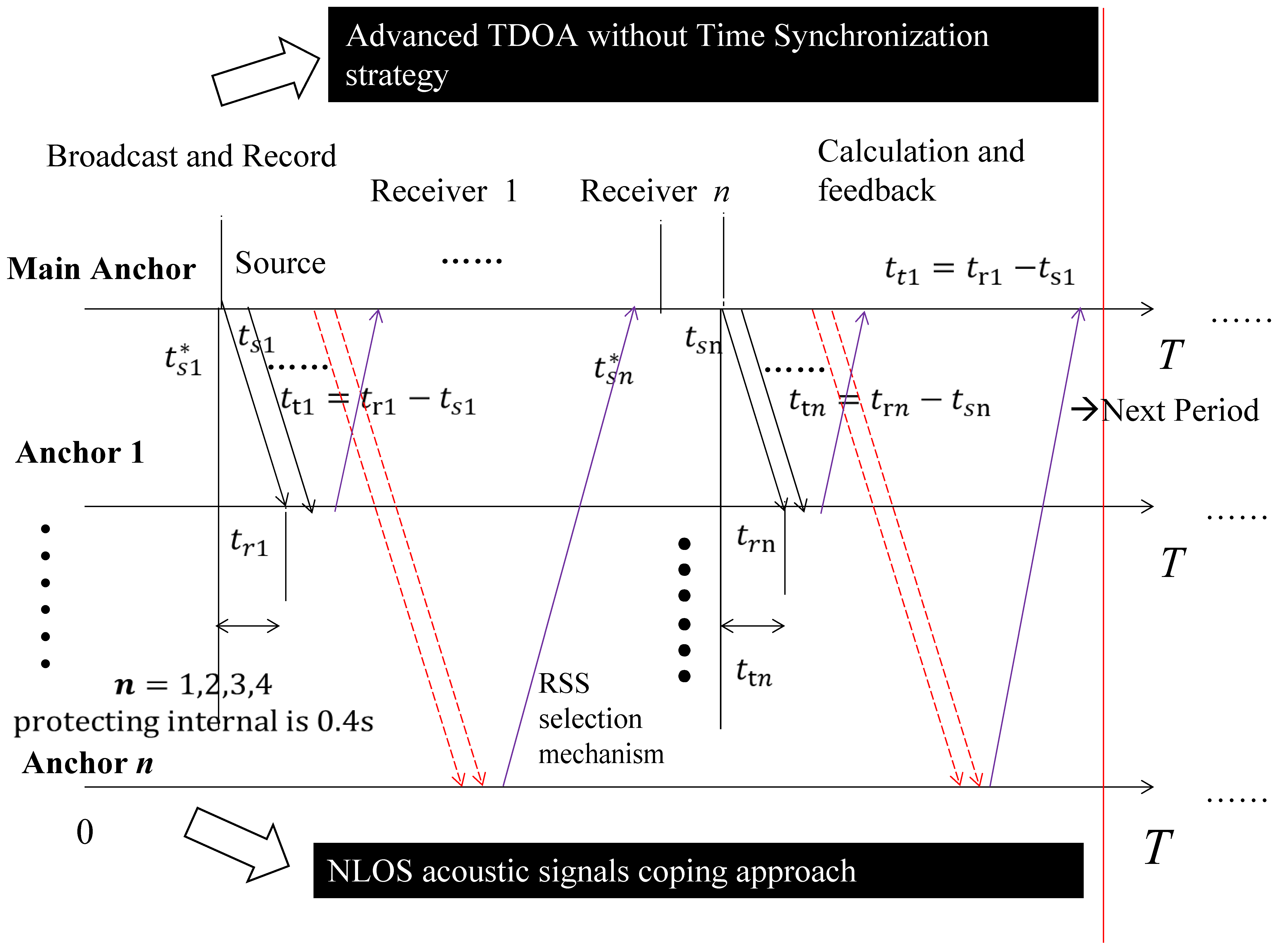
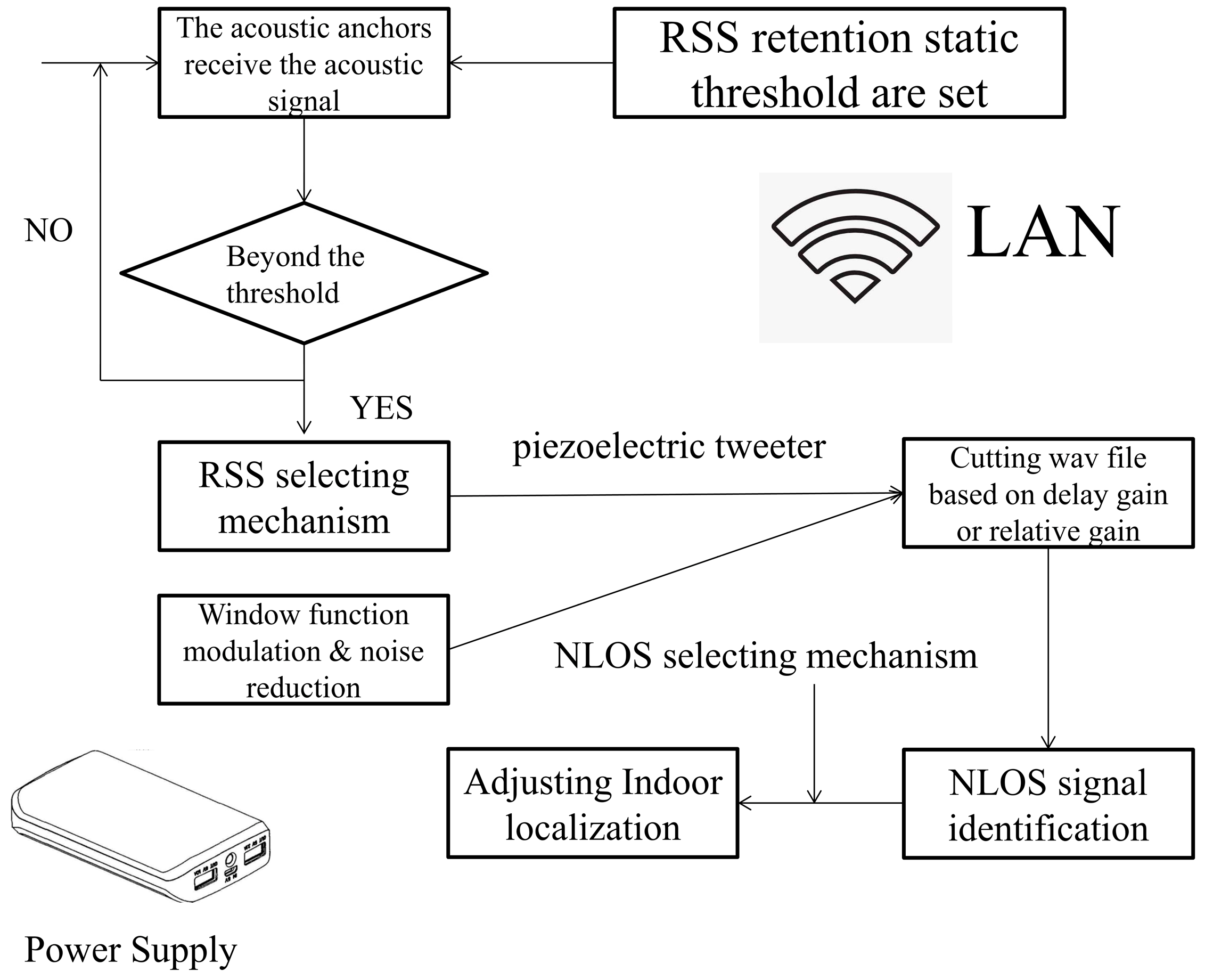
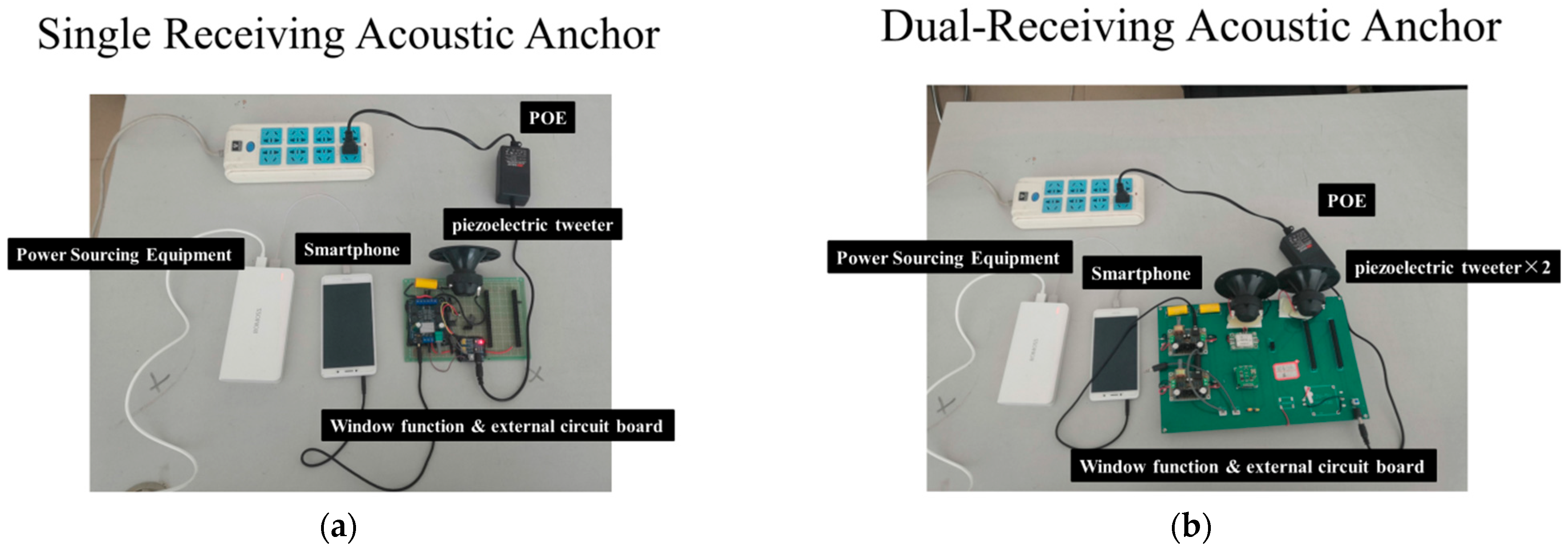
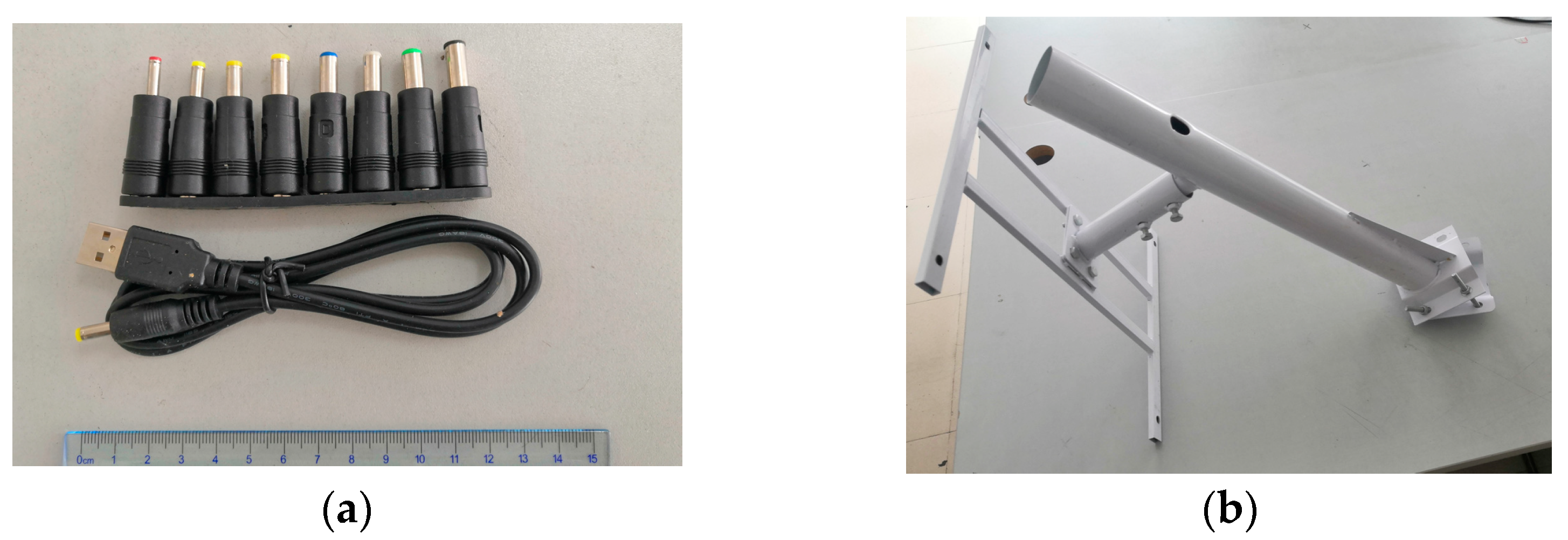
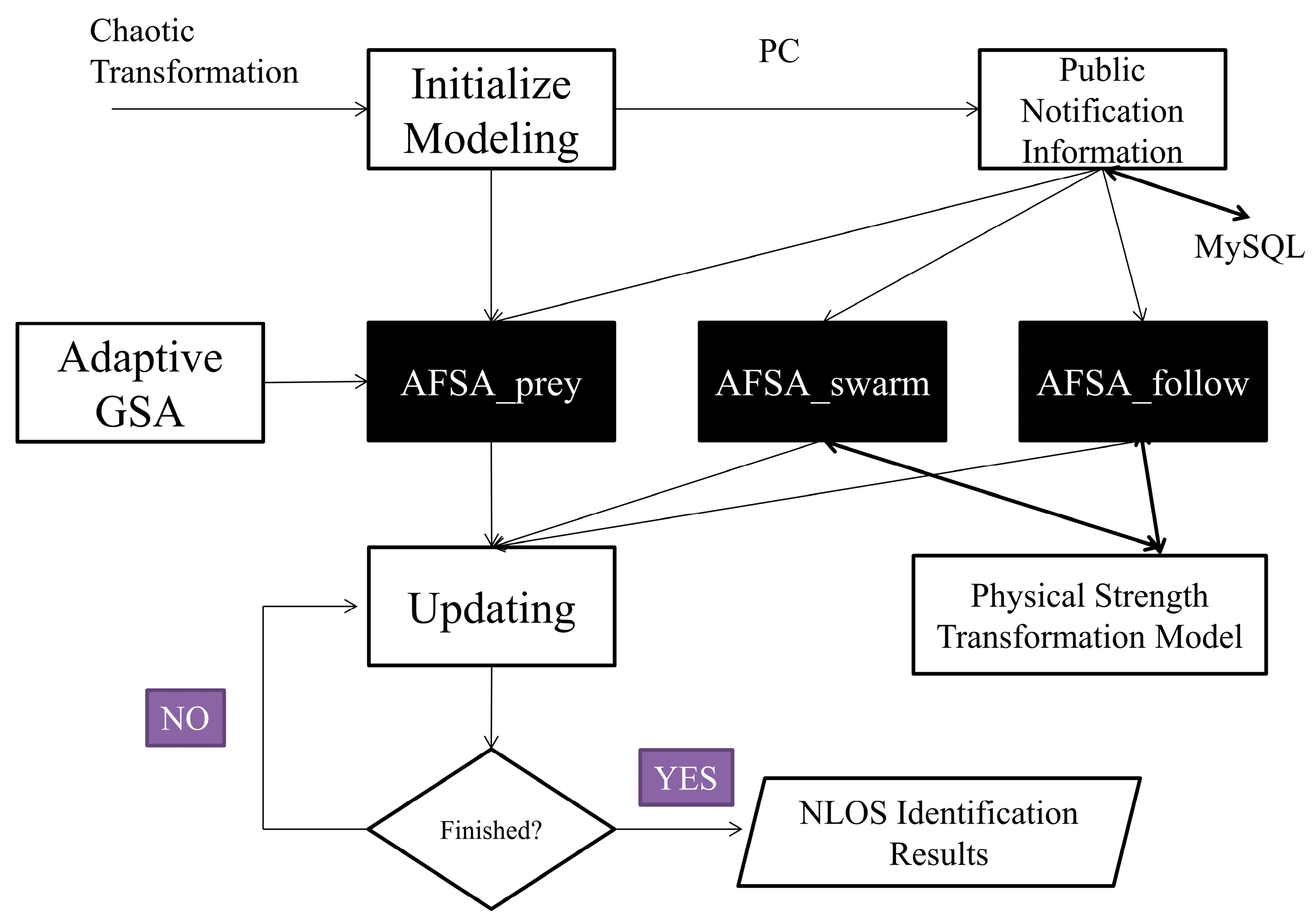
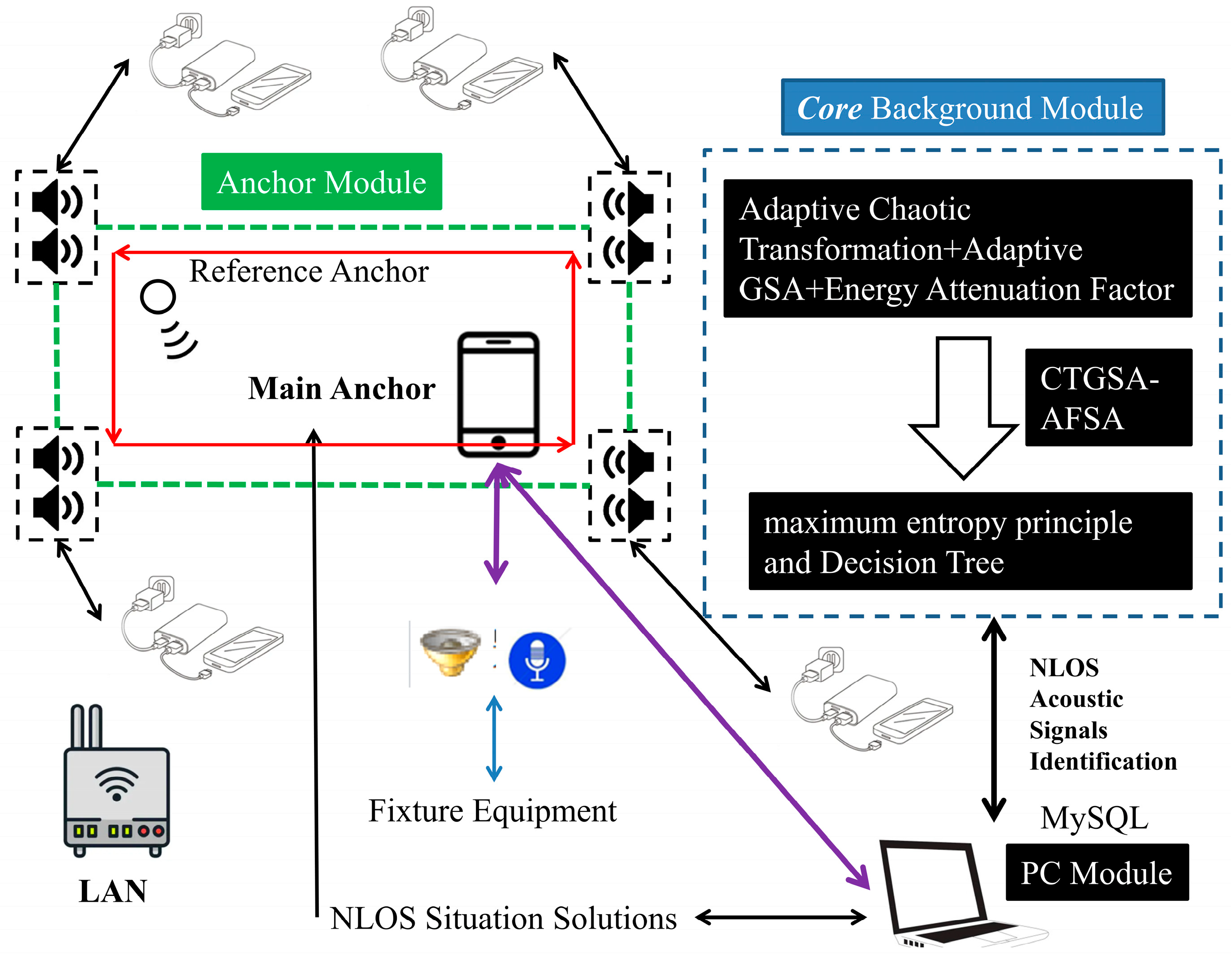

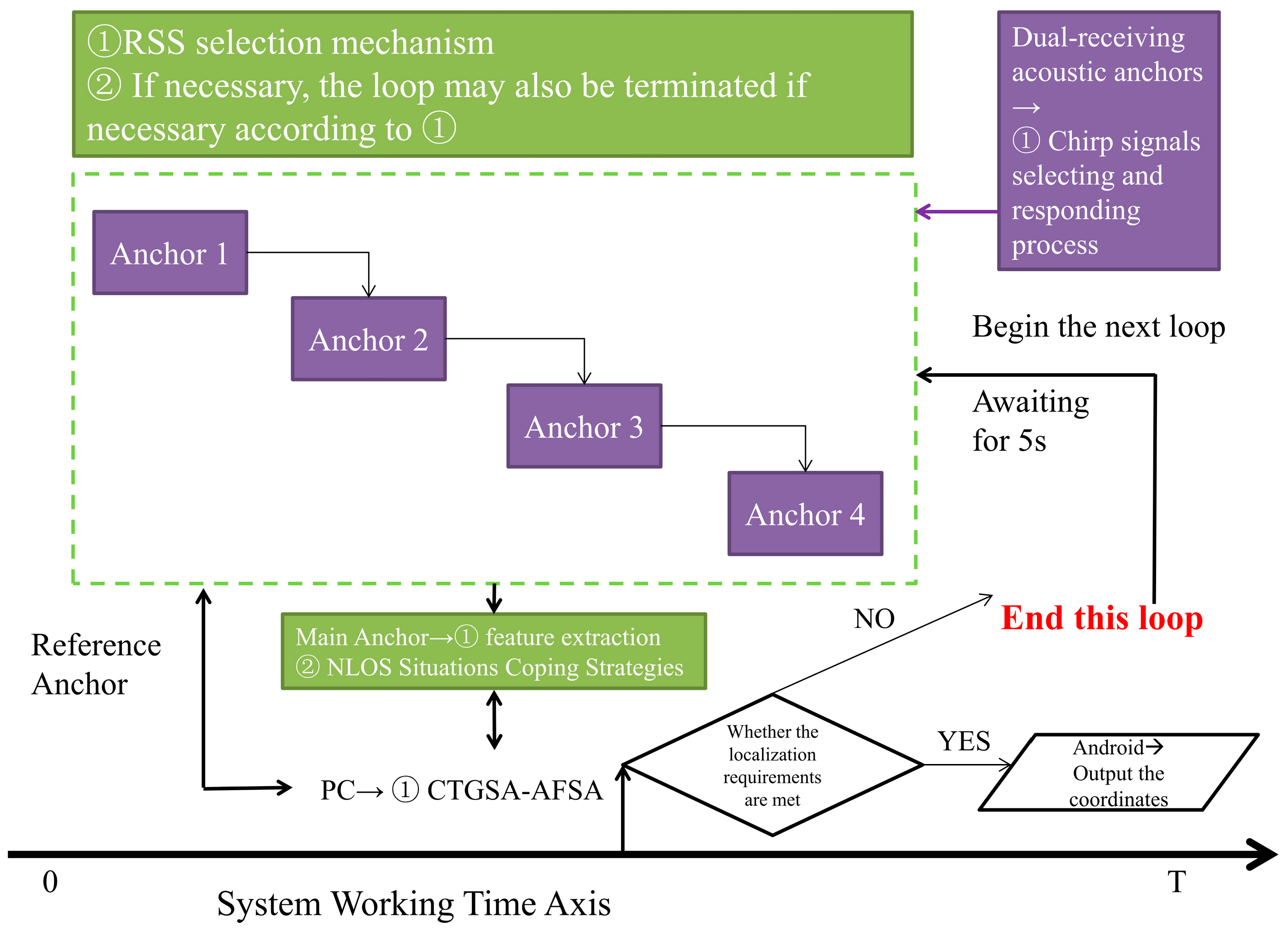
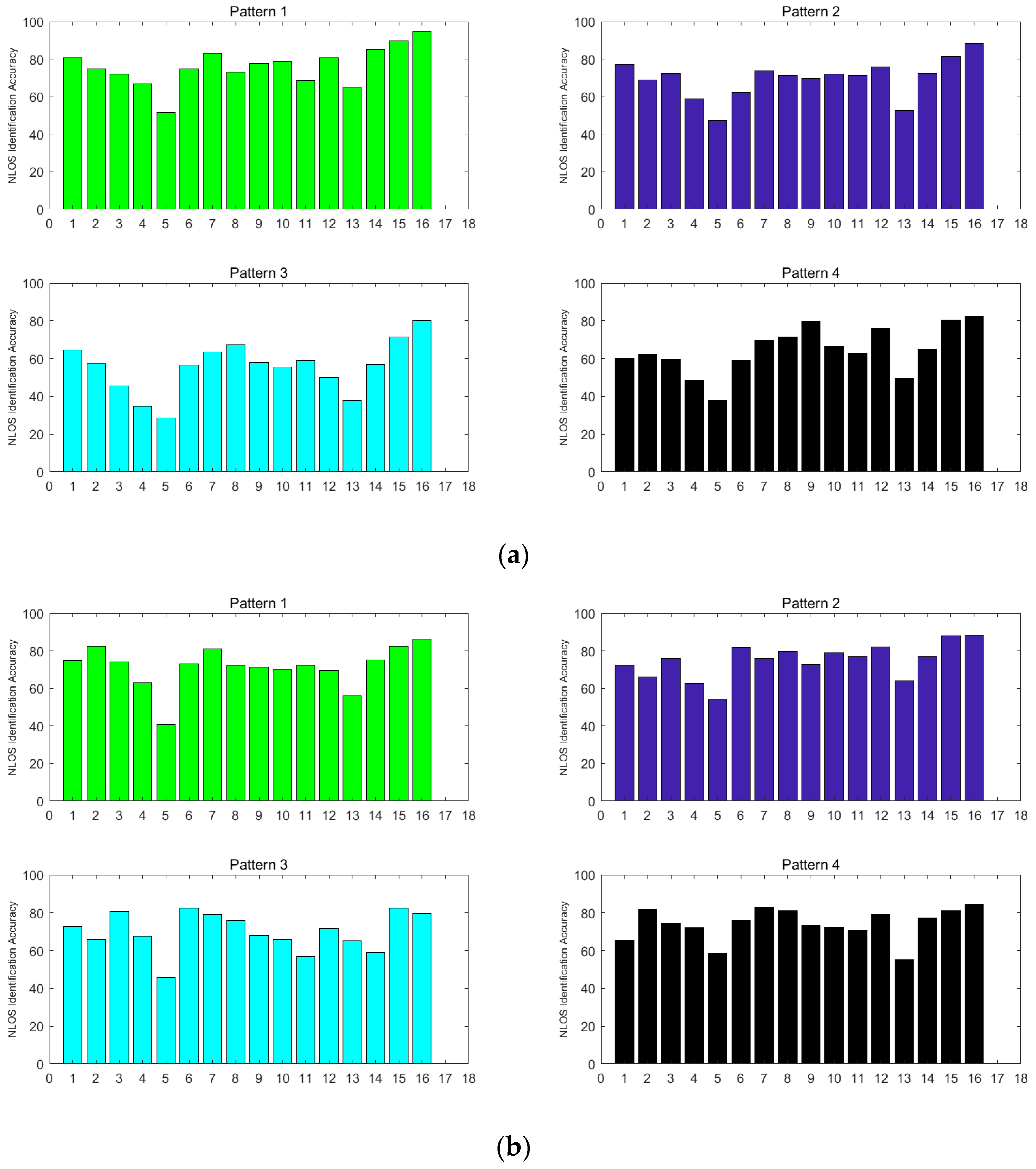
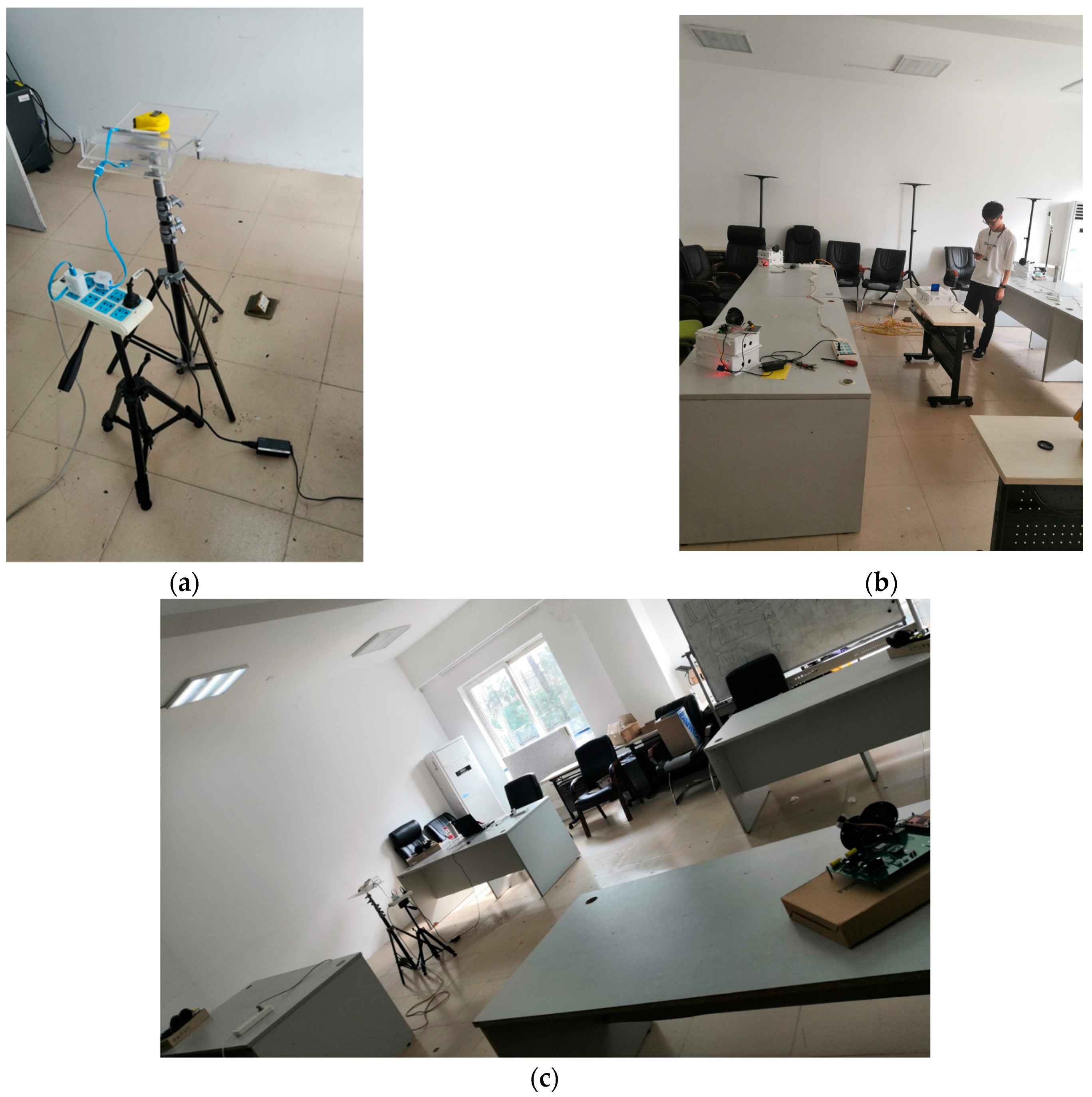
| AFSA-SVM Optimization Method | Average Running Time of This Method(s) | Accuracy |
|---|---|---|
| AFSA optimization method in [22] | 121.54 | 75.00% |
| AFSA optimization method in [39] | 87.43 | 70.52% |
| AFSA optimization method in [40] | 101.92 | 85.89% |
| AFSA optimization method in [41] | 89.01 | 82.13% |
| Our AFSA optimization method (CTGSA time is not added) | 65.91 | 82.19% |
| Algorithm | Time Each Receiving Process Is Completed | Accuracy |
|---|---|---|
| SVM (RBF as kernel function) | 1 | 81.7% |
| SVM (Linear kernel function) | 1 | 77.9% |
| SVM (Polynomial kernel function) | 1 | 70.1% |
| SVM (Sigmoid as kernel function) | 1 | 67.8% |
| Original logistic regression | 1 | 58.5% |
| Original DT | 1 | 79.8% |
| Method in [22] | 1 | 85.8% |
| DT + CTGSA − AFSA | 1 | 61.0% |
| SVM (RBF as kernel function) | 2 | 77.5% |
| SVM (Linear kernel function) | 2 | 78.6% |
| SVM (Polynomial kernel function) | 2 | 68.6% |
| SVM (Sigmoid as kernel function) | 2 | 80.6% |
| Original logistic regression | 2 | 65.1% |
| Original DT | 2 | 85.0% |
| Method in [21,22] | 2 | 90.9% |
| Method in this manuscript | 2 | 92.8% |
| Algorithm | Time Each Receiving Process Is Completed | Accuracy |
|---|---|---|
| SVM (RBF as kernel function) | 1 | 56.4% |
| SVM (Linear kernel function) | 1 | 55.5% |
| SVM (Polynomial kernel function) | 1 | 44.1% |
| SVM (Sigmoid as kernel function) | 1 | 49.8% |
| Original logistic regression | 1 | 37.1% |
| Original DT | 1 | 59.8% |
| Method in [22] | 1 | 72.0% |
| DT + CTGSA − AFSA | 1 | 66.7% |
| SVM (RBF as kernel function) | 2 | 52.4% |
| SVM (Linear kernel function) | 2 | 33.3% |
| SVM (Polynomial kernel function) | 2 | 66.7% |
| SVM (Sigmoid as kernel function) | 2 | 40.6% |
| Original logistic regression | 2 | 45.9% |
| Original DT | 2 | 85.2% |
| Method in [21,22] | 2 | 81.6% |
| Method in this manuscript | 2 | 83.3% |
| Average Error of X Axes Coordinate (m) | Average Error of Y Axes Coordinate (m) | Coordinate Error (m) | |
|---|---|---|---|
| (1, 1) | 0.0351 | 0.0622 | 0.0714 |
| (1, 1.5) | 0.0356 | 0.1538 | 0.1579 |
| (1, 2) | 0.0240 | 0.0474 | 0.0531 |
| (1, 2.5) | 0.0920 | 0.0981 | 0.1345 |
| (1.5, 2.5) | 0.0497 | 0.0623 | 0.0797 |
| (2, 2.5) | 0.0682 | 0.0654 | 0.0945 |
| (2.5, 2.5) | 0.0578 | 0.1009 | 0.1163 |
| (2.5, 2) | 0.1006 | 0.1591 | 0.1882 |
| (2.5, 1.5) | 0.0925 | 0.1495 | 0.1758 |
| (2.5, 1) | 0.0973 | 0.0994 | 0.1391 |
| (2, 1) | 0.0667 | 0.0525 | 0.0849 |
| (1.5, 1) | 0.0954 | 0.0578 | 0.1115 |
Disclaimer/Publisher’s Note: The statements, opinions and data contained in all publications are solely those of the individual author(s) and contributor(s) and not of MDPI and/or the editor(s). MDPI and/or the editor(s) disclaim responsibility for any injury to people or property resulting from any ideas, methods, instructions or products referred to in the content. |
© 2023 by the authors. Licensee MDPI, Basel, Switzerland. This article is an open access article distributed under the terms and conditions of the Creative Commons Attribution (CC BY) license (https://creativecommons.org/licenses/by/4.0/).
Share and Cite
Kan, R.; Wang, M.; Liu, X.; Liu, X.; Qiu, H. An Advanced Artificial Fish School Algorithm to Update Decision Tree for NLOS Acoustic Localization Signal Identification with the Dual-Receiving Method. Appl. Sci. 2023, 13, 4012. https://doi.org/10.3390/app13064012
Kan R, Wang M, Liu X, Liu X, Qiu H. An Advanced Artificial Fish School Algorithm to Update Decision Tree for NLOS Acoustic Localization Signal Identification with the Dual-Receiving Method. Applied Sciences. 2023; 13(6):4012. https://doi.org/10.3390/app13064012
Chicago/Turabian StyleKan, Ruixiang, Mei Wang, Xin Liu, Xiaojuan Liu, and Hongbing Qiu. 2023. "An Advanced Artificial Fish School Algorithm to Update Decision Tree for NLOS Acoustic Localization Signal Identification with the Dual-Receiving Method" Applied Sciences 13, no. 6: 4012. https://doi.org/10.3390/app13064012
APA StyleKan, R., Wang, M., Liu, X., Liu, X., & Qiu, H. (2023). An Advanced Artificial Fish School Algorithm to Update Decision Tree for NLOS Acoustic Localization Signal Identification with the Dual-Receiving Method. Applied Sciences, 13(6), 4012. https://doi.org/10.3390/app13064012







